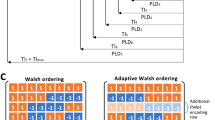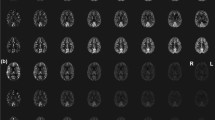Abstract
Objective
Arterial spin labelling (ASL) techniques benefit from the increased signal-to-noise ratio and the longer T 1 relaxation times available at ultra-high field. Previous pulsed ASL studies at 7 T concentrated on the superior regions of the brain because of the larger transmit radiofrequency inhomogeneity experienced at ultra-high field that hinders an adequate inversion of the blood bolus when labelling in the neck. Recently, researchers have proposed to overcome this problem with either the use of dielectric pads, through dedicated transmit labelling coils, or special adiabatic inversion pulses.
Materials and methods
We investigate the performance of an optimised time-resampled frequency-offset corrected inversion (TR-FOCI) pulse designed to cause inversion at much lower peak B +1 . In combination with a PICORE labelling, the perfusion signal obtained with this pulse is compared against that obtained with a FOCI pulse, with and without dielectric pads.
Results
Mean grey matter perfusion with the TR-FOCI was 52.5 ± 10.3 mL/100 g/min, being significantly higher than the 34.6 ± 2.6 mL/100 g/min obtained with the FOCI pulse. No significant effect of the dielectric pads was observed.
Conclusion
The usage of the B +1 -optimised TR-FOCI pulse results in a significantly higher perfusion signal. PICORE–ASL is feasible at ultra-high field with no changes to operating conditions.








Similar content being viewed by others
References
Rosen BR, Belliveau JW, Vevea JM, Brady TJ (1990) Perfusion imaging with NMR contrast agents. Magn Reson Med 14:249–265
Tofts PS, Kermode AG (1991) Measurement of the blood-brain barrier permeability and leakage space using dynamic MR imaging. 1. Fundamental concepts. Magn Reson Med 17:357–367
Detre JA, Leigh JS, Williams DS, Koretsky AP (1992) Perfusion imaging. Magn Reson Med 23:37–45
Williams DS, Detre JA, Leigh JS, Koretsky AP (1992) Magnetic resonance imaging of perfusion using spin inversion of arterial water. Proc Natl Acad Sci USA 89:212–216
Teeuwisse WM, Webb AG, van Osch MJP (2010) Arterial spin labeling at ultra-high field: all that glitters is not gold. Int J Imaging Syst Technol 20:62–70
Pfeuffer J, Adriany G, Shmuel A, Yacoub E, Van De Moortele P-F, Hu X, Ugurbil K (2002) Perfusion-based high-resolution functional imaging in the human brain at 7 Tesla. Magn Reson Med 47:903–911
Wang J, Alsop DC, Li L, Listerud J, Gonzalez-At JB, Schnall MD, Detre JA (2002) Comparison of quantitative perfusion imaging using arterial spin labeling at 1.5 and 4.0 Tesla. Magn Reson Med 48:242–254
Gardener AG, Gowland PA, Francis ST (2009) Implementation of quantitative perfusion imaging using pulsed arterial spin labeling at ultra-high field. Magn Reson Med 61:874–882
Ghariq E, Teeuwisse WM, Webb AG, van Osch MJP (2012) Feasibility of pseudocontinuous arterial spin labeling at 7 T with whole-brain coverage. MAGMA 25:83–93
Bause J, Ehses P, Mirkes C, Shajan G, Scheffler K, Pohmann R (2015) Quantitative and functional pulsed arterial spin labeling in the human brain at 9.4 T. Magn Reson Med. doi:10.1002/mrm.25671
Jahanian H, Noll DC, Hernandez-Garcia L (2011) B 0 field inhomogeneity considerations in pseudo-continuous arterial spin labeling (pCASL): effects on tagging efficiency and correction strategy. NMR Biomed 24:1202–1209
Luh W-M, Talagala SL, Li T-Q, Bandettini PA (2013) Pseudo-continuous arterial spin labeling at 7 T for human brain: estimation and correction for off-resonance effects using a Prescan. Magn Reson Imaging 69:402–410
Bernstein MA, King KF, Zhou XJ (2004) Handbook of MRI pulse sequences. Elsevier Academic Press, Amsterdam
Edelman RR, Siewert B, Adamis M, Gaa J, Laub G, Wielopolski P (1994) Signal targeting with alternating radiofrequency (STAR) sequences: application to MR angiography. Magn Reson Med 31:233–238
Wong EC, Buxton RB, Frank LR (1997) Implementation of quantitative perfusion imaging techniques for functional brain mapping using pulsed arterial spin labeling. NMR Biomed 10:237–249
Garcia D, de Bazelaire C, Alsop D (2005) Pseudo-continuous flow driven adiabatic inversion for arterial spin labeling. In: Proceedings of the 13th scientific meeting, International Society for Magnetic Resonance in Medicine, Miami Beach, p 37
Li X, Wang D, Auerbach EJ, Moeller S, Ugurbil K, Metzger GJ (2015) Theoretical and experimental evaluation of multi-band EPI for high-resolution whole brain pCASL Imaging. NeuroImage 106:170–181
Li X, Wang D, Moeller S, Ugurbil K, Metzger GJ (2014) Feasibility of applying MB EPI pCASL for high-resolution whole brain perfusion imaging at 7T. In: Proceedings of the 22nd scientific meeting, International Society for Magnetic Resonance in Medicine, Milan, p 995
Talagala SL, Ye FQ, Ledden PJ, Chesnick S (2004) Whole-brain 3D perfusion MRI at 3.0 T using CASL with a separate labeling coil. Magn Reson Med 52:131–140
Chuang K-H, Merkle H, Chesnick S, van Gelderen P, Koretsky AP, Duyn JH, Talagala SL (2005) Continuous arterial spin labeling perfusion MRI at 7T. In: Proceedings of the 13th annual meeting, ISMRM, Miami, 2005, p 1547
Ivanov D, Poser BA, Huber L, Pfeuffer J, Uludağ K (2014) Whole-brain perfusion measurements at 7T using pulsed arterial spin labelling and simultaneous multi-slice multi-echo echo planar imaging. In: Proceedings of the 22nd annual meeting, ISMRM, Milan, 2014, p 2698
Luh WM, Wong EC, Bandettini PA, Hyde JS (1999) QUIPSS II with thin-slice TI1 periodic saturation: a method for improving accuracy of quantitative perfusion imaging using pulsed arterial spin labeling. Magn Reson Med 41:1246–1254
Ordidge RJ, Wylezinska M, Hugg JW, Butterworth E, Franconi F (1996) Frequency offset corrected inversion (FOCI) pulses for use in localized spectroscopy. Magn Reson Med 36:562–566
Hurley AC, Al-Radaideh A, Bai L, Aickelin U, Coxon R, Glover P, Gowland PA (2010) Tailored RF pulse for magnetization inversion at ultrahigh field. Magn Reson Med 63:51–58
Silver M, Joseph R, Chen C-N, Sank V, Hoult D (1984) Selective population inversion in NMR. Nature 310:681–683
Jaynes E (1955) Matrix treatment of nuclear induction. Phys Rev 98:1099
Pauly J, Le Roux P, Nishimura D, Macovski A (1991) Parameter relations for the Shinnar–Le Roux selective excitation pulse design algorithm [NMR imaging]. IEEE Trans Med Imaging 10:53–65
O’Brien KR, Magill AW, Delacoste J, Marques JP, Kober T, Fautz H-P, Lazeyras F, Krueger G (2014) Dielectric pads and low- B1 + adiabatic pulses: complementary techniques to optimize structural T1w whole-brain MP2RAGE scans at 7 tesla. J Magn Reson Imaging 40:804–812
Garwood M, DelaBarre L (2001) The return of the frequency sweep: designing adiabatic pulses for contemporary NMR. J Magn Reson 153:155–177
Teeuwisse WM, Brink WM, Haines KN, Webb AG (2012) Simulations of high permittivity materials for 7 T neuroimaging and evaluation of a new barium titanate-based dielectric. Magn Reson Med 67:912–918
Klose U (1992) Mapping of the radio frequency magnetic field with a MR snapshot FLASH technique. Med Phys 19:1099–1104
Chung S, Kim D, Breton E, Axel L (2010) Rapid B1 + mapping using a preconditioning RF pulse with TurboFLASH readout. Magn Reson Med 64:439–446
Alsop DC, Detre JA, Golay X, Günther M, Hendrikse J, Hernandez-Garcia L, Lu H, Macintosh BJ, Parkes LM, Smits M, van Osch MJP, Wang DJJ, Wong EC, Zaharchuk G (2014) Recommended implementation of arterial spin-labeled perfusion MRI for clinical applications: a consensus of the ISMRM perfusion study group and the European consortium for ASL in dementia. Magn Reson Med. doi:10.1002/mrm.25197
Rane SD, Gore JC (2013) Measurement of T1 of human arterial and venous blood at 7 T. Magn Reson Imaging 31:477–479
Smith SM (2002) Fast robust automated brain extraction. Hum Brain Mapp 17:143–155
Zuo Z, Wang R, Zhuo Y, Xue R, St Lawrence KS, Wang DJJ (2013) Turbo-FLASH based arterial spin labeled perfusion MRI at 7 T. PLoS One 8:e66612
Frank LR, Wong EC, Buxton RB (1997) Slice profile effects in adiabatic inversion: application to multislice perfusion imaging. Magn Reson Med 38:558–564
Wang Y, Moeller S, Li X, Vu AT, Krasileva K, Ugurbil K, Yacoub E, Wang DJJ (2015) Simultaneous multi-slice Turbo-FLASH imaging with CAIPIRINHA for whole brain distortion-free pseudo-continuous arterial spin labeling at 3 and 7 T. NeuroImage 113:279–288
Adriany G (2014) A 16-channel arterial spin labeling—head transceiver array combination for 7 Tesla. In: Proceedings of the 22nd scientific meeting, International Society for Magnetic Resonance in Medicine, Milan, p 317
Acknowledgments
The authors thank Don Maillet and Rients Lootsma for their technical support with the scanner and the dielectric pads. MB acknowledges funding from Australian Research Council Future Fellowship Grant FT140100865. SB acknowledges funding from UQ Postdoctoral Research Fellowship grant. The authors acknowledge the facilities of the National Imaging Facility at the Centre for Advanced Imaging, University of Queensland and Siemens Healthcare Pty Ltd, Australia for development of the research prototype sequence.
Author information
Authors and Affiliations
Corresponding author
Ethics declarations
Conflict of interest
The authors declare that they have no conflict of interest.
Ethical approval
All procedures performed in studies involving human participants were in accordance with the ethical standards of the institutional and/or national research committee and with the 1964 Helsinki Declaration and its later amendments or comparable ethical standards.
Additional information
F. Zimmer and K. O’Brien contributed equally to this work.
Rights and permissions
About this article
Cite this article
Zimmer, F., O’Brien, K., Bollmann, S. et al. Pulsed arterial spin labelling at ultra-high field with a B +1 -optimised adiabatic labelling pulse. Magn Reson Mater Phy 29, 463–473 (2016). https://doi.org/10.1007/s10334-016-0555-2
Received:
Revised:
Accepted:
Published:
Issue Date:
DOI: https://doi.org/10.1007/s10334-016-0555-2




